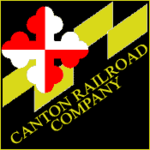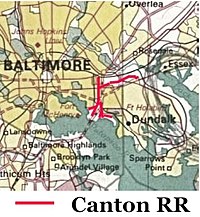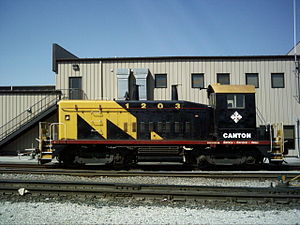
The Baltimore and Ohio Railroad was the first common carrier railroad and the oldest railroad in the United States. It operated as B&O from 1830 until 1987, when it was merged into the Chessie System; its lines are today controlled by CSX Transportation.

The Western Maryland Railway was an American Class I railroad (1852–1983) that operated in Maryland, West Virginia, and Pennsylvania. It was primarily a coal hauling and freight railroad, with a small passenger train operation.

A railroad car float or rail barge is a specialised form of lighter with railway tracks mounted on its deck used to move rolling stock across water obstacles, or to locations they could not otherwise go. An unpowered barge, it is towed by a tugboat or pushed by a towboat.

The Philadelphia, Wilmington and Baltimore Railroad (PW&B) was an American railroad that operated independently from 1836 to 1881. Headquartered in Philadelphia, it was greatly enlarged in 1838 by the merger of four state-chartered railroads in three Mid-Atlantic states to create a single line between Philadelphia and Baltimore.
Railway companies can interact with and control others in many ways. These relationships can be complicated by bankruptcies.

The Northern Central Railway (NCRY) was a Class I Railroad in the United States connecting Baltimore, Maryland, with Sunbury, Pennsylvania, along the Susquehanna River. Completed in 1858, the line came under the control of the Pennsylvania Railroad (PRR) in 1861, when the PRR acquired a controlling interest in the Northern Central's stock to compete with the rival Baltimore and Ohio Railroad (B&O).
OmniTRAX, Inc. is a transportation and transportation infrastructure holding company based in Denver, Colorado, in the United States. It primarily owns or operates railroads, with a network of 25 regional and shortline railroads in 12 U.S. states and three Canadian provinces. It is one of the largest privately owned railroad companies in the United States. The firm also invests in, develops, and operates ports, multimodal transportation terminals, and industrial parks.

Helen Delich Bentley Port of Baltimore is a shipping port along the tidal basins of the three branches of the Patapsco River in Baltimore, Maryland on the upper northwest shore of the Chesapeake Bay. It is the nation's largest port facilities for specialized cargo and passenger facilities. It is operated by the Maryland Port Administration (MPA), a unit of the Maryland Department of Transportation.
The Virginia Port Authority (VPA) is an autonomous agency of the Commonwealth of Virginia that owns The Port of Virginia, a group of facilities with their activity centered on the harbor of Hampton Roads, Virginia.
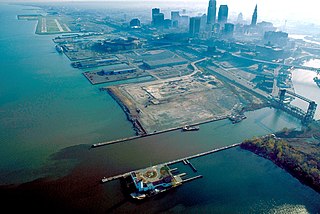
The Port of Cleveland is a bulk freight and container shipping port at the mouth of the Cuyahoga River on Lake Erie in Cleveland, Ohio, United States. It is the third-largest port in the Great Lakes and the fourth-largest Great Lakes port by annual tonnage. Over 20,000 jobs and $3.5 billion in annual economic activity are tied to the roughly 13 million tons of cargo that move through Cleveland Harbor each year.
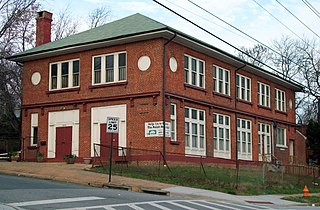
Polish Home Hall is a historic building located in the waterfront industrial/commercial/residential and heavily ethnic community of Curtis Bay in southern Baltimore, Maryland,. Built on the southwest corner of Fairhaven Avenue and Filbert Street near the top of the commanding heights overlooking to the east the sloping streets of the neighborhood of Curtis Bay, about four city blocks wide and 15 blocks length.

The Baltimore Terminal Subdivision is a railroad line owned and operated by CSX Transportation in the U.S. state of Maryland. The line runs from Baltimore to Halethorpe along the original Baltimore and Ohio Railroad (B&O) line, one of the oldest rail lines in the United States and the first passenger railroad line. At its east (north) end, it connects with the Philadelphia Subdivision; its west (south) end has a junction with the Capital Subdivision and the Old Main Line Subdivision.

"Mount Winans" is a mixed-use residential, commercial and industrial neighborhood in the southwestern area of the City of Baltimore in Maryland. Its north, south and east boundaries are marked by the various lines of track of the CSX Railroad. In addition, Hollins Ferry Road running to the south towards suburban Baltimore County in the southwest and further connecting with adjacent Anne Arundel County to the southeast, draws its western boundary.
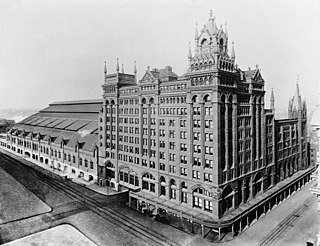
The Philadelphia, Baltimore and Washington Railroad (PB&W) was a railroad that operated in Pennsylvania, Delaware, Maryland, and the District of Columbia in the 20th century, and was a key component of the Pennsylvania Railroad (PRR) system. Its 131-mile (211 km) main line ran between Philadelphia and Washington. The PB&W main line is now part of the Northeast Corridor, owned by Amtrak.
The Delaware Coast Line Railroad was a short-line railroad located in Sussex County, Delaware. The company operated two lines on track owned by the State of Delaware: one running from Ellendale east to Milton and another running from Georgetown east to Cool Spring. The railroad interchanged with the Delmarva Central Railroad in Ellendale and Georgetown. It was owned by Dan Herholdt. Part of the rail lines were taken over by the Delmarva Central railroad.
The Patapsco and Back Rivers Railroad was a Class III switching and terminal railroad, operating in Baltimore County. Owned for the majority of its existence by the Bethlehem Steel Corporation, the railroad primarily served Bethlehem Steel's Sparrows Point Terminal area. MCM Management Corporation purchased the PBR, through their purchase of RG Steel corporation, and renamed the railroad the Baltimore Industrial Railroad in 2012. RG Steel, LLC
Tradepoint Rail, formerly known as the Baltimore Industrial Railroad, is a switching and terminal railroad located on Sparrows Point, Maryland in the industrial sector of Baltimore, Maryland.
The Baltimore, Chesapeake and Atlantic railroad, nicknamed Black Cinders & Ashes, ran from Claiborne, Maryland, to Ocean City, Maryland. It operated 87 miles (140.0 km) of center-line track and 15.6 miles (25.11 km) of sidings. Chartered in 1886, the railroad started construction in 1889 and cost $2.356 million ($2024=76,736,000).
